Mary stood outside the tomb weeping. As she wept, she knelt to look into the tomb and saw two angels sitting there, dressed in white, one at the head, the other at the foot of where Jesus’ body had been laid. They said to her, “Woman, why do you weep?”
“They took my Master,” she said, “and I don’t know where they put him.” After she said this, she turned away and saw Jesus standing there. But she didn’t recognize him.
Jesus spoke to her, “Woman, why do you weep? Who are you looking for?”
She, thinking that he was the gardener, said, “Mister, if you took him, tell me where you put him so I can care for him.”
Jesus said, “Mary.”
Turning to face him, she said in Hebrew, “Rabboni!” meaning “Teacher!”
Jesus said, “Don’t cling to me, for I have not yet ascended to the Father. Go to my brothers and tell them, ‘I ascend to my Father and your Father, my God and your God.’ ”
Mary Magdalene went, telling the news to the disciples: “I saw the Master!” And she told them everything he said to her. (John 20:11–18)
The angels asked Mary a question: “why do you weep?” From Mary’s perspective, it seemed obvious: Jesus was dead, someone had moved his body, and now she couldn’t even mourn properly. An already bad situation had gotten even worse.
Moments later, someone else asked her the same question, “why do you weep?” She was distraught, she had tears in her eyes. Jesus was supposed to be dead. So she didn’t recognize it was Jesus himself asking the question that time.
Jesus asked her the question for the same reason that the angels had. Of course they understood she was sad, and of course they understood why. Neither the angels nor Jesus were asking for enlightenment. They were asking to make Mary reexamine her situation. She didn’t have a reason to weep anymore. Couldn’t she see that?
When Jesus spoke her name, she suddenly could see that. Her tears probably didn’t vanish in that instant, but they certainly took on an entirely different character: they became tears of joy.
Mary realized her circumstances were radically different than what she had imagined. The storms and trials of life can buffet us so severely sometimes that we lose sight of the fullness of our own circumstances. Although our suffering is no less real, no less painful, if we can keep our eyes on Jesus, the storms of life will not buffet us quite as hard.
 Send to Kindle
Send to Kindle
 A Year With God
A Year With God A Year With Jesus
A Year With Jesus The Bible's Most Fascinating People
The Bible's Most Fascinating People The Bible: A Reader's Guide
The Bible: A Reader's Guide Antediluvian
Antediluvian Inheritance
Inheritance John of the Apocalypse
John of the Apocalypse Somewhere Obscurely
Somewhere Obscurely The Wrong Side of Morning
The Wrong Side of Morning